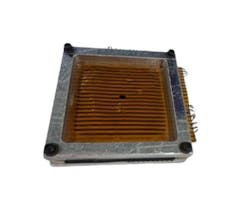The Next Decade of Tactile Sensing: Evolution and Trajectory of Tactile Sensing
What you'll learn:
- The history of tactile sensing and how it has arrived where it is today.
- Factors that are accelerating adoption across industries.
- Why the next decade will transform innovation and commercialization of tactile sensing.
For over three decades, Tekscan, a pioneer in the realm of tactile sensing, has been at the forefront of market innovation and application mastery. Originating from a groundbreaking thin-film flexible pressure-sensor prototype developed by MIT engineers (see figure), Tekscan has since developed an extensive understanding of market dynamics and application requirements.
This expertise highlights an impending convergence of factors — a "perfect storm" — where sensor innovation combined with manufacturing advances meet an escalating demand driven by essential market needs.
Looking forward, the tactile sensor industry is on the brink of a significant transformation, propelled by manufacturing breakthroughs and the increasing incorporation of these technologies into everyday products. As we continue to push the boundaries of what's possible, the gap between innovative research and commercial success is expected to close, ushering in a new era of sensor technology that's more sensitive, adaptive, and integrated than ever before.
Since its inception, the tactile sensing market has been evolving steadily. As with any evolution, the journey has been characterized by punctuated equilibrium with step changes in the market. It’s led to a rapid growth in new application pathways, which then mature and stabilize until the next disruption occurs.
Evolutionary disruptions along the way have included advances in conductive and resistive inks, improved FPGA modules enabling real-time programmable logic, and open-source software leading to rapid development of data analytics and user interfaces, among others.
The relative stability in commercial application growth over the past decade, excluding the effects of the global pandemic, is poised for change. The tactile sensing market is about to witness a convergence of technical and market forces that will disrupt and accelerate the industry over the next 10 years. This is due to several factors:
- Innovation: The tactile sensor innovation engine has been running hot for the past decade in the race to support emerging growth market applications, including touchscreens, gaming controls, robotics, medical wearables, and other markets.
- Manufacturing advances: The ability to manufacture more complex printed flexible electronics designs, as well as more efficient scale for standardized designs, will be leveraged with new production investments to drive growth.
- Increased market adoption: As the industry continues to scale up and commercialize tactile sensing technologies, improved availability combined with reduced manufacturing costs will drive market adoption levels at a faster pace.
All of these trends have the potential to feed on each other, resulting in a power curve effect that accelerates growth dramatically over the coming decade.
Market Adoption of Tactile Sensing
Tactile sensors, generally defined as measuring some aspect of “touch,” are often compared with the abilities of human skin. Currently, mainstream applications are limited mainly to sensing force and pressure over a surface area. Experimental niche technologies exist to sense other surface or contact characteristics like temperature, surface slippage, roughness, and other factors.
>>Check out the other parts of this series
Tactile sensors have proven their functionality and are already operating in a very broad spectrum of applications. Tekscan alone has penetrated thousands of uses for research, applications, systems solutions based on tactile sensing, or embedded sensors in various devices. Combined with emerging entrants into the market, the breadth of adoption growth is astounding.
The market for tactile sensors is now generally estimated at over $30 billion annually. The largest market area for tactile touch sensing is, of course, in touchscreen displays and controllers, which are embedded into a wide variety of consumer, medical, military, and industrial products representing over 80 % of tactile applications.
While touchscreen technology is relatively mature, advances in materials and manufacturing continue to evolve. To make screens more ‘tactile’, developers are seeking to measure touch pressure or pressure distribution, in addition to position, leading to new innovations. The market for printed flexible sensors is widely estimated at over $3 billion per year, with tactile sensors representing a portion of the total.
About the Author

John Jutila
CEO, Tekscan
John Jutila is CEO of Tekscan, a global leader of tactile sensor solutions. John previously held CEO positions at Ripley Tools, a supplier of infrastructure installation solutions, and Champion ONE, an optical networking technology company, as well as several positions at Nokia, including VP Strategy & Operations for Global Strategic Alliances, COO of the Strategic Industries Division EMEA Region, and North American Division President for Optical Fiber solutions.
John has also held key executive positions at Asahi Kasei/Polypore for microporous membrane technology, InterDigital for advanced mobile phone technology, and HP/EDS for IT outsourcing. He holds a DBA from Grenoble Ecole de Management, an MBA from the University of Toledo, and a BBA in Venture Management from The Wharton School.


